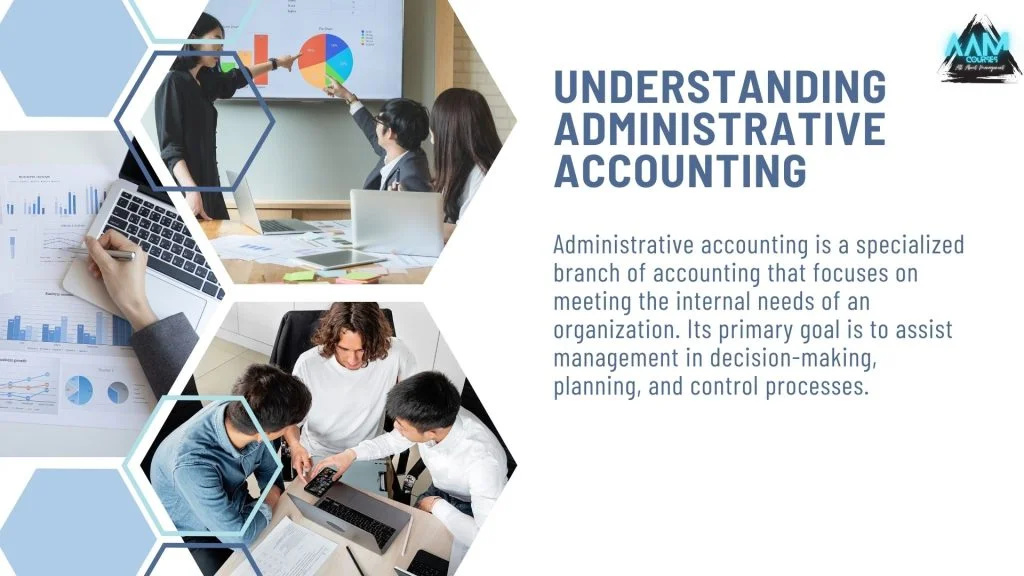Administrative accounting, also known as management accounting, is a crucial function within a business. It is primarily concerned with providing relevant financial and non-financial information to internal stakeholders, particularly management. Unlike financial accounting, which creates financial statements for external stakeholders, administrative accounting focuses on serving the needs of the company’s internal operations.
This article explores the core functions, tools, and significance of administrative accounting in today’s business environment.
Understanding Administrative Accounting

Administrative accounting is a specialized branch of accounting that focuses on meeting the internal needs of an organization. Its primary goal is to assist management in decision-making, planning, and control processes.
By offering detailed insights into different aspects of business operations, administrative accounting helps managers make informed decisions that improve efficiency and profitability.
ALSO READ ABOUT The Golden Rules of Accounting – The 3 Rules
Key Functions of Administrative Accounting

1. Planning and Budgeting
One of the core functions of administrative accounting is the planning and budgeting processes. It involves forecasting future revenues, expenses, and resource requirements. Accountants use past data and market trends to develop a strategic goal that serves as a benchmark for evaluating actual performance.
2. Cost Management
Administrative accountants include understanding, evaluating, and controlling costs related to various business operations. These costs include both direct and indirect costs. By monitoring and controlling these costs, businesses can increase their profitability and competitive edge.
3. Performance Measurement
Administrative accounting contains tools and metrics that are used to measure the performance of different departments, projects, and individuals. These tools and metrics allow managers to identify areas of improvement and take corrective actions.
4. Decision Support
Administrative accountants play a crucial role by providing valuable insights for strategic decision-making. This includes conducting cost-benefit analyses, break-even analyses, and scenario planning.
By providing relevant financial information clearly and concisely, accountants help managers evaluate different options and choose the best course of action.
5. Internal Control and Risk Management
Administrative accountants have to ensure they protect and maintain the integrity of the financial data and other organizational assets. To protect these assets, accountants enforce internal control systems that prevent fraud, errors, and other inefficiencies. They also conduct risk assessments to identify threats and then devise a plan to reduce their impact
Tools and Techniques in Administrative Accounting
Administrative accounting relies on various tools and techniques to perform its core functions. Some of the most widely used tools and techniques are mentioned and explained below:

1. Standard Costing
Standard costing is a technique where the accountants assign a specific cost to a product or service based on their calculations. The assigned cost serves as the benchmark that helps to evaluate and measure the actual cost needed, identifying the variance.
By analyzing the variance, managers can re-evaluate their process and pinpoint the point of deviation. This helps to identify the areas where the cost exceeded more than expected and take corrective actions.
2. Activity-Based Costing (ABC)
ABC is a method that assigns overhead costs to products and services based on their consumption of activities. This is a more accurate technique that allows managers to identify inefficiencies and correct them.
3. Balanced Scorecard
A balanced scorecard is a management tool that converts organizational goals into 4 sets of KPIs: financial, customer, internal processes, and learning and growth. This approach allows managers to focus on both, the financial and non-financial aspects of the business.
4. Variance Analysis
Variance analysis is the process of comparing the real results of the cost versus the planned results to identify the deviation points. Once these points have been identified, managers can use corrective measures to reduce the extra cost and move forward as planned.
5. Contribution Margin Analysis
Another popular technique is contribution margin analysis. This technique evaluates the contribution margin of all products and services and other operations. A contribution margin is the gap between sales revenue and variable costs.
By reviewing the contribution margin, managers can understand the inefficiencies in the operations and make more informed decisions for pricing, product mix, and resource allocation.
Importance of Administrative Accounting
Administrative accounting is essential for the smooth functioning and growth of an organization. Its importance can be summarized in the following points:
1. Informed Decision-Making
Administrative accounting provides managers with timely and accurate information that plays a crucial role in decision-making. Accurate and reliable data are the core of every decision, whether it is for asset investment, resource allocation, or pricing strategy.
2. Strategic Planning
An administrative account provides reliable data about the current market situation, market competitors, and internal operations that are of great importance while formulating long-term strategies.
3. Performance Improvement
Administrative accounting is a continuous process. It continuously monitors and evaluates the performance of various operations to determine new areas for improvement. Such continuity leads to better performance, cost reduction, and enhanced overall operations.
4. Risk Management
Administrative accounting plays a key role in identifying and mitigating risk factors. By identifying areas with potential risk, managers can strategize to eliminate or reduce the impact of these threats.
5. Transparency and Accountability
By providing valuable insights into the business’s internal operations, administrative accounting promotes transparency and accountability within the organization. Such practices build a culture of trust and responsibility among employees and stakeholders.
Future Trends in Administrative Accounting
Finance is the core of every business, and it keeps evolving every year with new technologies and ideas. Along with finance, its sub-functions also evolve, contributing towards the greater evolution. Here are some upcoming trends in administrative accounting:
1. Digital Transformation
Finance has already been integrated with digital technology, but new digital technologies such as artificial intelligence, Big data, and machine learning integration are on their way to transforming the field of administrative accounting.
Integration with these new technologies will lead to more accurate data analysis, an automated reposting system, and reliable predictive modeling.
2. Sustainability Accounting
Administrative accounting promotes sustainability and corporate social responsibility by incorporating environmental, social, and governance (ESG) factors into performance measurement and reporting. Such sustainable practices help organizations to complete their societal duties.
3. Cloud-Based Solutions
The rapid growth of cloud usage is bound to reach the accounting world. The flexibility and accessibility offered by the cloud will allow organizations to streamline their accounting processes.
4. Enhanced Data Security
With the world significantly depending on digital technology, financial aspects become the top security priority for every business and individual. Administrative accounting systems are increasingly putting more effort into enhancing the security of their system to protect such sensitive information.
5. Integrated Reporting
An integrated report containing both financial and non-financial information is gaining momentum. Such a report provides a consolidated preview of the organization’s performance and its impact on various stakeholders.
Distinguishing Administrative Accounting from Financial Accounting
| Key Differences | Administrative Accounting | Financial Accounting |
| Purpose | The main purpose of the administrative account is to provide internal management with relevant financial and non-financial data for strategic planning and cost control. | The primary purpose of financial accounting is to provide external stakeholders such as investors and creditors with a snapshot of the company’s financial position. |
| Users | Administrative accounting is used by internal management which includes managers, executives, and department heads. | Financial accounting serves external stakeholders who are interested in the financial well-being of the firm. |
| Reporting | Administrative accounting generates a report for internal management with information about various aspects of business operations, such as cost analysis, budget variance, and performance metrics. | Financial accounting generates financial statements based on accounting principles. These reports include the balance sheet, cash flow statement, and income statement. |
| Time Orientation | Administrative accounting is future-oriented, focusing on forecasting, budgeting, and planning. It helps management anticipate future trends, allocate resources effectively, and set strategic objectives. | Financial accounting is primarily historical, recording and reporting past financial transactions and events. It provides a snapshot of the organization’s financial performance and position at specific points in time. |
ALSO READ ABOUT Small Business Expense Management: 10 Strategies for Success
FAQs
What is the meaning of administrative accounting?
Administrative accounting is a specialized branch of accounting that focuses on meeting the internal needs of an organization. Its primary goal is to assist management in decision-making, planning, and control processes.
What are the functions of administration accounting?
The 5 key functions of administrative accounting are as follows:
1. Planning and Budgeting
2. Cost Management
3. Performance Measurement
4. Decision Support
5. Internal Control and Risk Management
Why is administrative accounting important?
Administrative accounting provides internal management with crucial data about current operations of the business that helps the managers make informed decisions, strategize, enhance performance, mitigate risk from potential threats, and promote transparency and accountability in the organization.
What is the difference between administrative accounting and financial accounting?
Here are the key points that distinguish administrative accounting and financial accounting:
1. Purpose and Objectives
2. Users and Stakeholders
3. Reporting and Analysis
4. Time Orientation
Final Statement
Administrative accounting is a vital function that supports the internal management of an organization. By providing accurate and timely information, it enables informed decision-making, strategic planning, and performance improvement.
I hope this article on Administrative accounting is informative. Use the comment box to ask questions and doubts.

